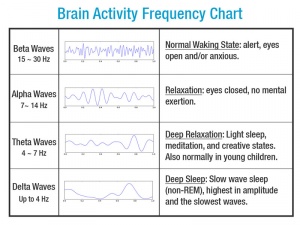Brain Signals
The physiological function of our brain works by complex sets of electrical patterns and neuro-chemical processes, made through a variety of impulse signals. Some of these impulses may signal our brain from environmental and external forces of frequency, or brain signals may be internally generated from our own thought frequency. It is extremely important to know that the state of one's brain frequency is what changes and shifts one's state of Consciousness. When one meditates and calms their mind, they change their brain frequency and can alter frequencies throughout the body.
The human brain is composed of Neurons, glial cells (that surround and protect the neurons), and blood vessels. The cerebral cortex is nearly symmetrical with left (male) and right (female) hemispheres that are mirror images of each other. The left and right cerebral hemispheres are interconnected by the corpus callosum, a very large nerve bundle on the crown. The hidden job of the Crown Chakra is to activate the Corpus Callosum to join the left and the right hemispheres of the brain, into one unified neurological and synaptic signaling function. Once the brain is unified in quality of vibrational thought pattern (female creative feeling uniting with male reasoning into thought balance), the energy of the entire body's right (male) side and left (female) side start to unify within the brain. This process of neurological unification, brain unification, thought unification and male and female energetic balance starts with the mind and consciousness, that is focused on unification (unity). This activation of higher intelligence is the process, which interconnects all layers of the complex matrices of the human body through a unified consciousness of male and female principles. When the male and female are unified within, we are able to connect to consciousness and communicate with levels of intelligence unknown to science.
Neurons are the core components of the nervous system. There are approximately one hundred billion neurons connected by more than one hundred trillion synapses in the human brain. Neurons are basically electrical on and off switches, which work in a similar way to the small transistors found in computer chips. Information is passed between neurons via the chemical synapses, which release neurotransmitters, which act on another neuron. Most neurons are connected via synapses to several thousand other neurons, making the brain's circuitry capable of connecting to a host of neural networks.
These signals between neurons occur via synapses, or specialized connections with other cells. Neurons can connect to each other to form neural networks. The key to neural function in the central nervous system is the synaptic signaling process, which is partly electrical and partly chemical. When the synaptic signaling is interrupted through toxic electrical frequencies (i.e. such as technological Mind Control in low EMF pulsing, harmful radiation) or the synaptic signaling is interrupted through an introduction to toxic chemicals, heavy metals (i.e. mercury and aluminum in Vaccinations, Chemtrails) the synapse will not signal. When the synapse stops functioning and/or is poisoned, the neuron will eventually die. When neurons die, humans get motor neuron and brain diseases like Alzheimer's and ALS. Have you ever felt that headache after a vaccine? That's the feeling of your immune system trying to stop the chemicals from eating your brain's neurons.[1]
